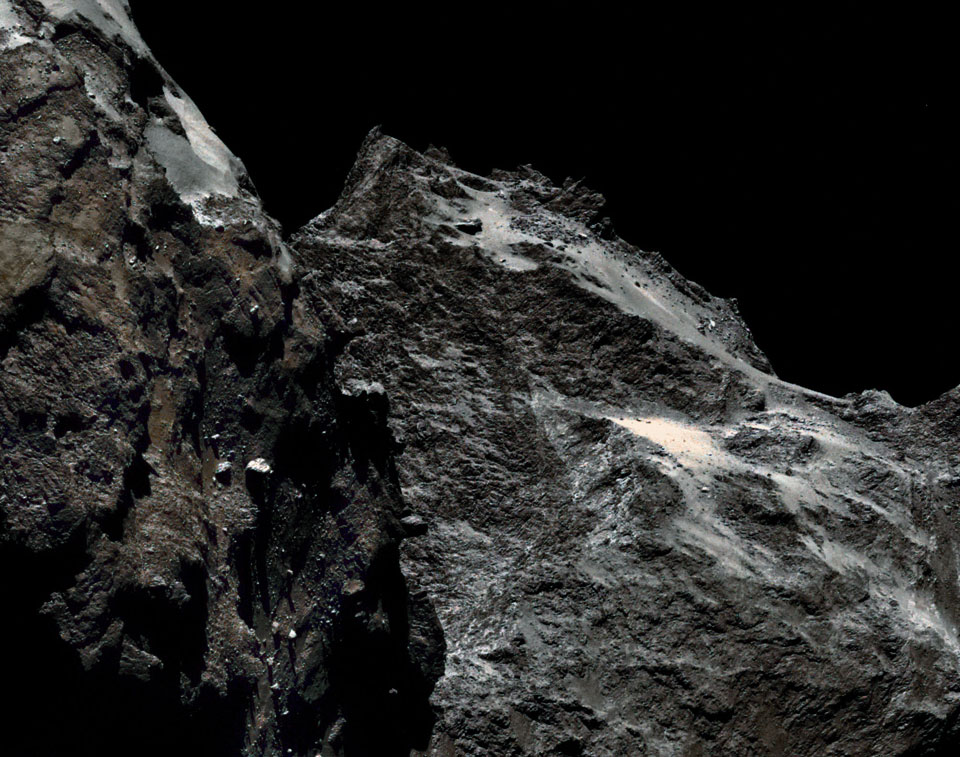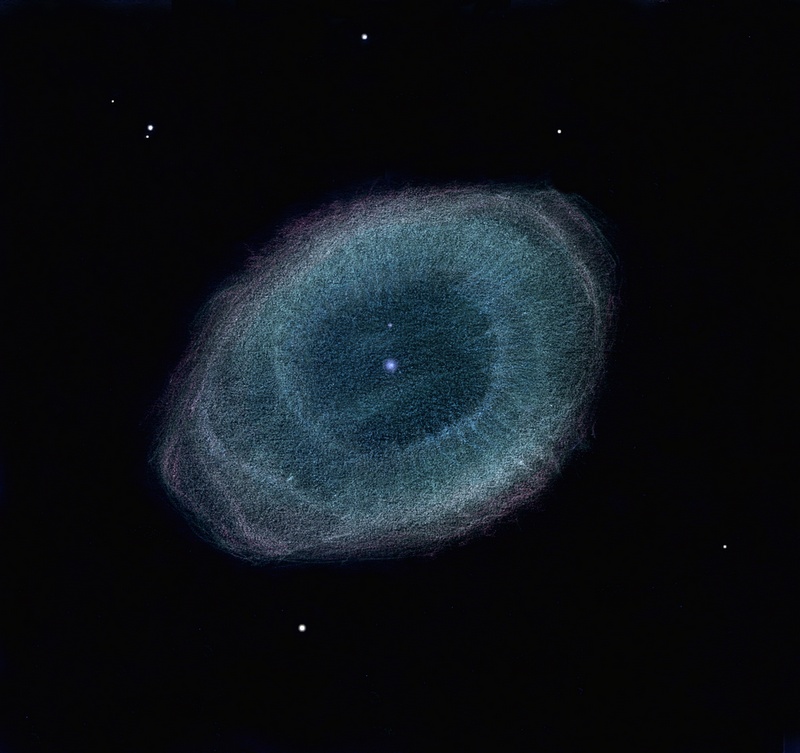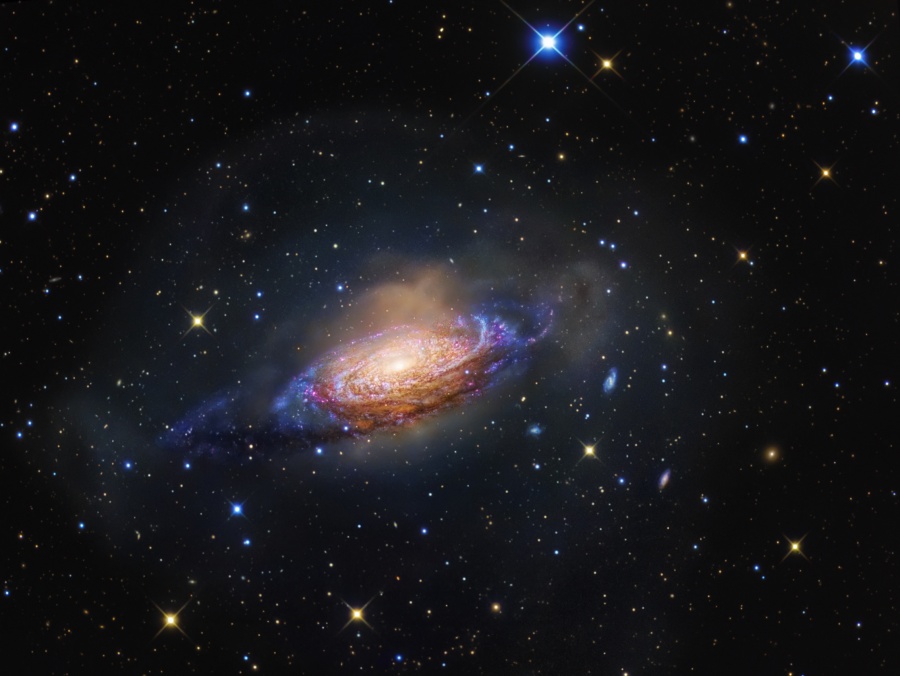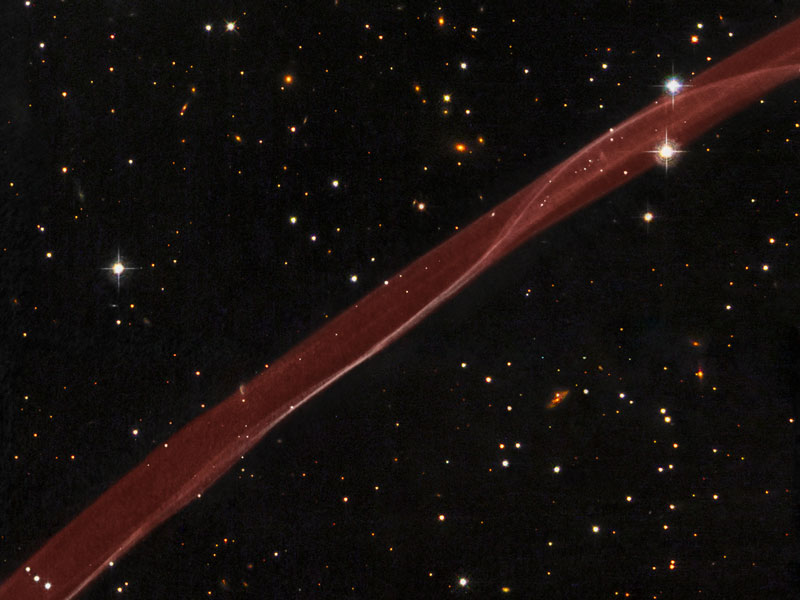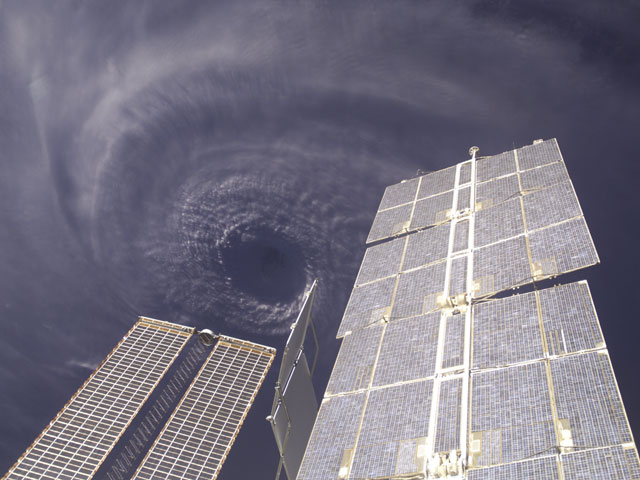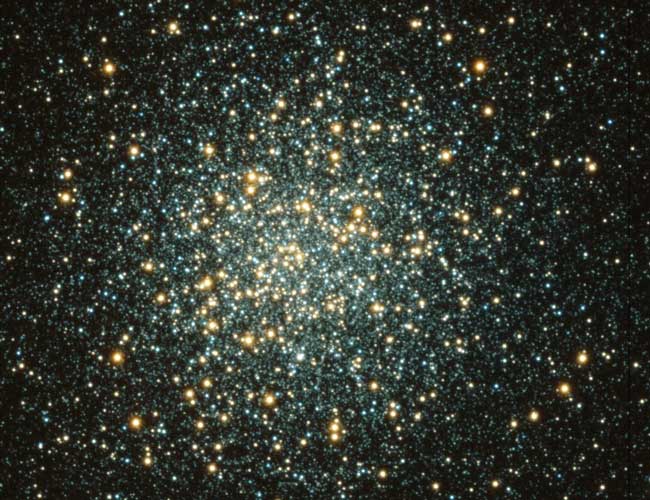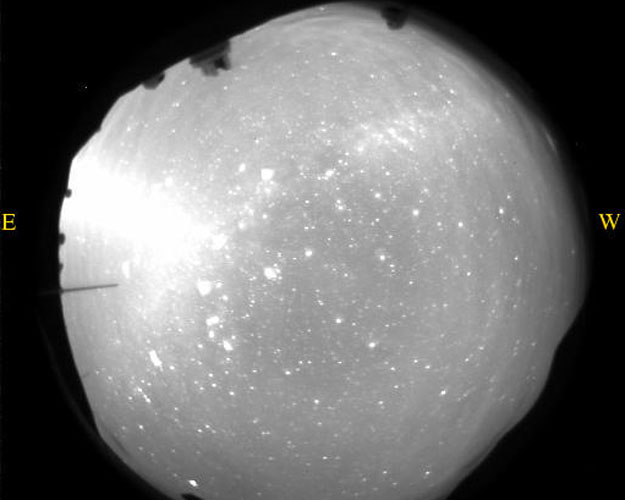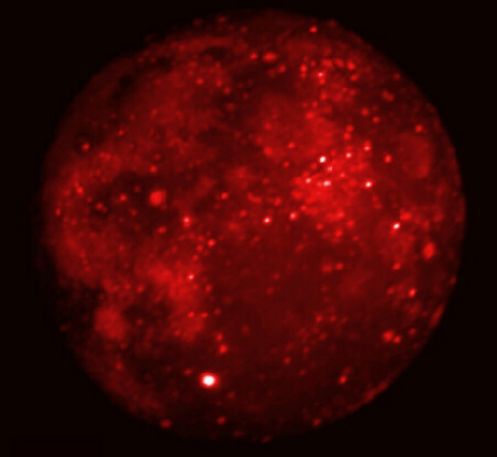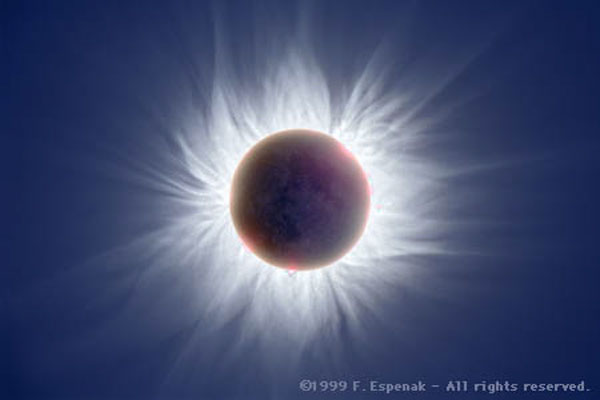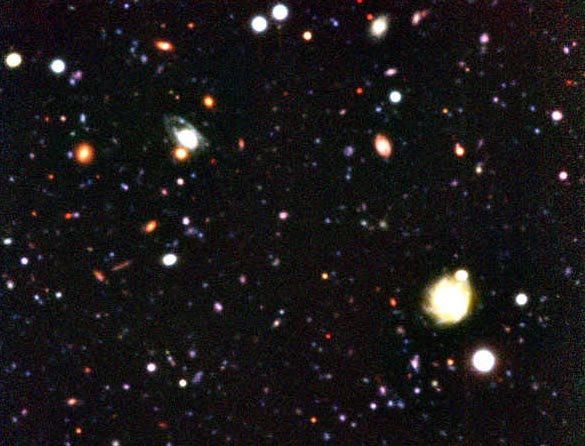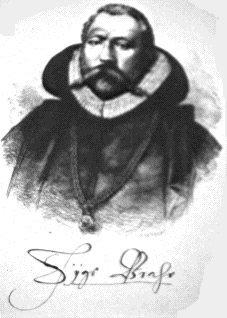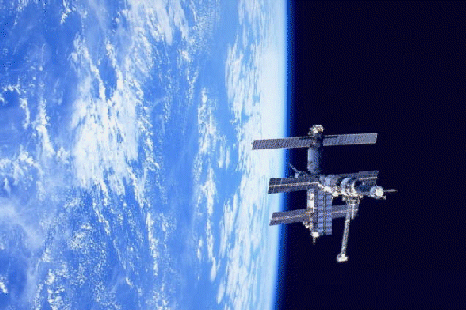| << Previous | Index | Next >> |
2015 What's happened to the sky? Aurora! Captured late last month, this aurora was noted by Icelanders for its great brightness and quick development. The aurora resulted from a solar storm, with high energy particles bursting out from the Sun and through a crack in Earth's protective magnetosphere a few days later. Although a spiral pattern can be discerned, creative humans might imagine the complex glow as an atmospheric apparition of any number of common icons. In the foreground of the featured image is the Ölfusá River, while the lights illuminate a bridge in Selfoss City. Just beyond the low clouds is a nearly full Moon. The liveliness of the Sun -- and the resulting auroras on Earth -- is slowly diminishing as the Sun emerges from a Solar maximum of surface activity and evolves towards a historically more quite period in its 11-year cycle. In fact, solar astronomers are waiting to see if the coming Solar minimum will be as unusually quiet as the last one, where sometimes months would go by with no discernible sunspots or other active solar phenomena.
2014
2013 Are stars better appreciated for their art after they die? Actually, stars usually create their most artistic displays as they die. In the case of low-mass stars like our Sun and M2-9 pictured above, the stars transform themselves from normal stars to white dwarfs by casting off their outer gaseous envelopes. The expended gas frequently forms an impressive display called a planetary nebula that fades gradually over thousand of years. M2-9, a butterfly planetary nebula 2100 light-years away shown in representative colors, has wings that tell a strange but incomplete tale. In the center, two stars orbit inside a gaseous disk 10 times the orbit of Pluto. The expelled envelope of the dying star breaks out from the disk creating the bipolar appearance. Much remains unknown about the physical processes that cause planetary nebulae.
2012 A planetary nebula with a simple symmetry familiar to telescopic sky gazers, the Ring Nebula (M57) is some 2,000 light-years away in the musical constellation Lyra. Hints of changing colors and subtle details are brought out in this remarkable sketch of the cosmic ring. The sketch was made with 800x magnification and excellent seeing conditions directly at the eyepiece of a 40 inch reflecting telescope. Colored pencils on white paper were used to create the original drawing, shown here digitally scanned with an inverted palette applied. About one light-year across, the nebula is composed of outer layers expelled from a dying, once sun-like star. Intense ultraviolet light from the hot central star ionizes atoms in the gas and powers the nebular glow. Ionized hydrogen adds a reddish tint. Ionized oxygen produces a characteristic blue-green color. Difficult to see under average conditions with small telescopes, the Ring Nebula's central star was visible at all times during the artist's study.
2011
2010 Sometimes the sky above can become quite a show. Last week, for example, the Moon and Venus converged, creating quite a sight by itself for sky enthusiasts around the globe. From some locations, though, the sky was even more picturesque. In the above image taken last week from Spain, a crescent Moon and the planet Venus, on the far right, were captured during sunset posing against a deep blue sky. In the foreground, dark storm clouds loom across the image bottom, while a white anvil cloud shape appears above. Black specks dot the frame, caused by a flock of birds taking flight. Very soon after this picture was taken, however, the birds passed by, the storm ended, and Venus and the Moon set. The Moon and Venus have now separated, although Venus will remain visible at sunset for the rest of this month.
2009 NGC 6888, also known as the Crescent Nebula, is a cosmic bubble about 25 light-years across, blown by winds from its central, bright, massive star. This beautiful portrait of the nebula is from the Isaac Newton Telescope at Roque de los Muchachos Observatory in the Canary Islands. It combines a composite color image with narrow band data that isolates light from hydrogen and oxygen atoms in the wind-blown nebula. The oxygen atoms produce the blue-green hue that seems to enshroud the detailed folds and filaments. NGC 6888's central star is classified as a Wolf-Rayet star (WR 136). The star is shedding its outer envelope in a strong stellar wind, ejecting the equivalent of the Sun's mass every 10,000 years. The nebula's complex structures are likely the result of this strong wind interacting with material ejected in an earlier phase. Burning fuel at a prodigious rate and near the end of its stellar life this star should ultimately go out with a bang in a spectacular supernova explosion. Found in the nebula rich constellation Cygnus, NGC 6888 is about 5,000 light-years away.
2008 What created this unusual space ribbon? Most assuredly, one of the most violent explosions ever witnessed by ancient humans. Back in the year 1006 AD, light reached Earth from a stellar explosion in the constellation of the Wolf (Lupus), creating a "guest star" in the sky that appeared brighter than Venus and lasted for over two years. The supernova, now cataloged at SN 1006, occurred about 7,000 light years away and has left a large remnant that continues to expand and fade today. Pictured above is a small part of that expanding supernova remnant dominated by a thin and outwardly moving shock front that heats and ionizes surrounding ambient gas. SN 1006 now has a diameter of nearly 60 light years. Within the past year, an even more powerful explosion occurred far across the universe that was visible to modern humans, without any optical aid, for a few seconds.
2007 This bizarre, equatorial ridge extending across and beyond the dark, leading hemisphere of Iapetus gives the two-toned Saturnian moon a distinct walnut shape. With red/blue glasses you can check out a remarkable stereo composition of this extraordinary feature -- based on close-up images from this week's Cassini spacecraft flyby. In fact, the ridge's combination of equatorial symmetry and scale, about 20 kilometers wide and reaching up to 20 kilometers above the surface, is not known to be duplicated anywhere else in our solar system. The unique feature was discovered in Cassini images from 2004. It appears to be heavily cratered and therefore ancient, but the origin of the equatorial ridge on Iapetus remains a mystery.
2006 Fix your camera to a tripod, lock the shutter open, and you can make an image of star trails - graceful concentric arcs traced by the stars as planet Earth rotates on its axis. Of course, the length of the star trails will depend on the exposure time. While exposures lasting just five minutes produce a significant arc, in about 12 hours a given star would trace out half a circle. But in any long exposure, the background glow from light-polluted skies can build up to wash out the trails. Still, astronomer Josch Hambsch produced this stunning composite of star trails around the South Celestial Pole with an effective "all night" exposure time of almost 11 hours. To do it, he combined 128 consecutive five minute long digital exposures recorded in very dark night skies above Namibia. In his final image, the background glow on the right is due in part to the faint, arcing Milky Way.
2005 Approaching the nucleus of comet Tempel 1 at ten kilometers per second, the Deep Impact probe's targeting camera recorded a truly dramatic series of images. Successive pictures improve in resolution and have been composited here at a scale of 5 meters per pixel -- including images taken within a few meters of the surface moments before the July 4th impact. Analyzing the resulting cloud of debris, researchers are directly exploring the makeup of a comet, a primordial chunk of solar system material. Described as a recipe for primordial soup, the list of Tempel 1's ingredients - tiny grains of silicates, iron compounds, complex hydrocarbons, and clay and carbonates thought to require liquid water to form - might be more appropriate for a cosmic souffle, as the nucleus is apparently porous and fluffy. Seen here, Tempel 1's nucleus is about five kilometers long, with the impact site between the two large craters near the bottom.
2004 Ninety percent of the houses on Grenada were damaged. Such is the destructive force of Hurricane Ivan, already one of the most powerful and destructive hurricanes on record. And the storm will likely make landfall in southern USA tomorrow. Ivan is the currently the third - and largest - hurricane set to strike the US this hurricane season. The swirling eye of Hurricane Ivan was photographed above from the orbiting International Space Station (ISS) on Saturday as the storm's sustained 200 kilometer per hour winds wreaked havoc in the Caribbean. The bad news is that hurricane season in the Atlantic typically lasts until November 30, still over two months away. The more immediate bad news is that tropical storm Jeanne is next in line coming across the mid-Atlantic Ocean and could pass Puerto Rico sometime today.
2003 This huge ball of stars predates our Sun. Long before humankind evolved, before dinosaurs roamed, and even before our Earth existed, ancient globs of stars condensed and orbited a young Milky Way Galaxy. Of the 200 or so globular clusters that survive today, M3 is one of the largest and brightest, easily visible in the Northern hemisphere with binoculars. M3 contains about half a million stars, most of which are old and red. Light takes about 100,000 years to reach us from M3, which spans about 150 light years. The above picture is a composite of blue and red images.
2002 An unusual triangle of light will be particularly bright near the eastern horizon before sunrise during the next two months for observers in Earth's northern hemisphere. Once considered a false dawn, this triangle of light is actually Zodiacal Light, light reflected from interplanetary dust particles. The triangle is clearly visible on the left of the above frame taken from Mauna Kea in Hawaii on September 8 by one of the developing global network of fisheye nighttime web cameras, called CONCAMs, of the Night Sky Live Project. Zodiacal dust orbits the Sun predominantly in the same plane as the planets: the ecliptic. Zodiacal light is so bright this time of year because the dust band is oriented nearly vertical at sunrise, so that the thick air near the horizon does not block out relatively bright reflecting dust. Zodiacal light is also bright for people in Earth's northern hemisphere in March and April just after sunset.
2001 The total lunar eclipse of September 1996 disappointed many observers in North America who were cursed with cloudy skies. However, the Midcourse Space Experiment (MSX) satellite had a spectacular view from Earth orbit and SPIRIT III, an onboard infrared telescope, was used to repeatedly image the moon during the eclipse. Above is one of the images taken during the 70 minute totality, the Moon completely immersed in the Earth's shadow. Infrared light has wavelengths longer than visible light - human's can not see it but feel it as heat. The bright spots correspond to the warm areas on the lunar surface, dark areas are cooler. The brightest spot below and left of center is the crater Tycho, the dark region at the upper right is the Mare Crisium. The series of SPIRIT III images allow the determination of cooling rates for geologically different areas, exploring the physical properties of the Moon's surface.
2000 The aurora borealis, or northern lights, are not a common sight in the southwestern United States. But a strong solar coronal mass ejection in early August triggered geomagnetic storms and aurora which were widely reported, even under west Texas skies. This striking view of the aurora was recorded from a site near El Paso, Texas and the Hueco Tanks State Historical Park at a latitude just shy of 32 degrees north. Polaris is the brightest star visible near the top and right of center while a Perseid meteor pierces the auroral glow left of picture center, below the bowl of the little dipper. Want to see an aurora? Dark skies and high latitudes (closer to the north or south poles) help. And you might keep an eye on the space weather report. The last big coronal mass ejection headed toward planet Earth was detected by space-based instruments on September 12. It may trigger geomagnetic storms and auroral activity beginning September 14th.
1999 Most photographs don't adequately portray the magnificence of the Sun's corona. Seeing the corona first-hand during a total solar eclipse is best. The human eye can adapt to see features and extent that photographic film usually cannot. Welcome, however, to the digital age. The above picture is a combination of twenty-two photographs that were digitally processed to highlight faint features. The outer pictures of the Sun's corona were digitally altered to enhance dim, outlying waves and filaments. The inner pictures of the usually dark Moon were enhanced to bring out its faint glow from doubly reflected sunlight. Shadow seekers need not fret, though, since as yet there is no way that digital image processing can mimic the fun involved in experiencing a total solar eclipse.
1998 What happens if you point a large telescope at nothing? The above New Technology Telescope SUSI Deep Field photograph isolated a small patch of sky picked to contain no bright objects at all. A very long exposure was then taken, similar to the Hubble Deep Field, in order to see the many faint objects that are usually washed out by the light of bright foreground objects. What remains is a cosmic wallpaper rich in distant galaxies. Galaxies as faint as magnitude 26 were found to be irregularly distributed, with several unusual pairings of different colored objects. This and other deep field images are being released for detailed inspection by anyone interested. New deep field images are being planned.
1997 The largest volcano in the Solar System is on Mars. Olympus Mons rises 24 kilometers high and measures 550 km across. By comparison, Earth's largest volcano, Mauna Loa in Hawaii, rises 9 km high and measures 120 km across. Such large volcanoes can exist on Mars because of the low gravity and lack of surface tectonic motion. Olympus Mons is a shield volcano, built by fluid lava. Over the next three years, Mars Global Surveyor, which arrived at Mars last week, will photograph the planet at such high resolution that objects only 100 meters across will be visible. The above image was taken by Mariner 9, which orbited and photographed Mars during 1971 and 1972.
1996 Tycho Brahe was the most meticulous astronomical observer of his time. Brahe, who lived between 1546 and 1601, set out to solve the day's most pressing astronomical problem: to determine whether the Earth or the Sun was at the center of the Solar System. To do this he and his assistants created the first major astronomical observatory where they devised and used the most accurate pre-telescopic astronomical instuments. Tycho Brahe thus compiled tables of precise measurements of the positions and brightnesses of planets and stars. Brahe never solved the Solar System problem himself - but left data so impressively accurate his assistant Johannes Kepler was able to develop definitive laws. Brahe is also remembered for witnessing a supernova in 1572, showing that the Great Comet of 1577 was not an atmospheric phenomena, and for his metal nose.
1995 This picture of the Russian space station Mir over the Pacific Ocean was recorded by the Space Shuttle Discovery in February 1995. During this mission Discovery performed a rendezvous and "fly around" with Mir in preparation for a future docking mission. Many scientific experiments and astronomical observations were completed jointly by the American astronauts and the Russian cosmonauts. An IMAX camera took many pictures of this historic encounter. Some cosmonauts have spent more than a year on board Mir, the longest anyone has ever lived in space. Work on an International Space Station is in progress.
| << Previous | Index | Next >> |

